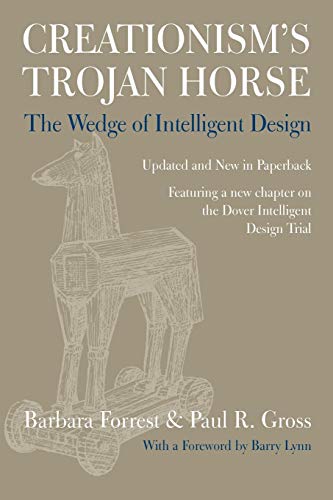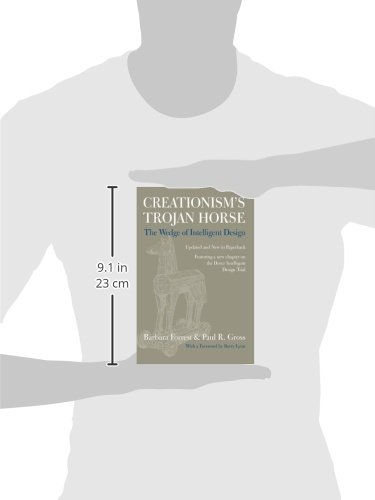Customer Services
Copyright © 2025 Desertcart Holdings Limited
Desert Online General Trading LLC
Dubai, United Arab Emirates




Full description not available
K**T
Connecting the Dots.
Undoubtedly, this is a book that needed to be writen. In Creationism's Trojan Horse (CTH) Forrest and Gross attempt to show readers, via many angles, that Intelligent Design should not be allowed (and actively is not allowed) into the world of science. They do this not only by exposing the flawed, and woefully "mistake"-laden, works of those like Michael Behe and William Demski, but also by linking just about all major proponents of Intelligent Design to evangelical christian missions. If a person was only allowed to read one book to state the case against ID, this should be it.The first chapters focus on the 'science' of the whole thing. One chapter, for instance, is devoted to Intelligent Design's very strange claim that the Cambrian Explosion should be causing a major problem to evoltionists. How can all of these forms just suddenly appear out of nowhere, the ID theorists ask? To ask this of course is to woefully misunderstand what is meant by "explosion." These forms did not suddenly appear, that is, unless by "suddenly" we mean over millions of years! Evolutionists have known this for quite some time, but it is news to the ID crea. And what about the absence of pre-Cambrian fossils? Not quite true, of course (and this is why evolutionists are not worried on this score, rather than ID's charge that it is a cover-up conspiracy.) The fossil record here is not as rich as would be liked, but it exists. These fossils not only didn't come from nowhere; any responsible - key word, that - should have known this.We also get a thorough treatment on two of ID's stars - Michael Behe and William Dembski. The chapter on Behe shows us a man who simply seems rather oblivious to most critics. Forrest and Gross meticulously document the thorough rebuttals Behe has recieved and his thorough lack of response to these. Many of Behe's claims that certain organisms are irreducibly complex - that there is no way they could have evolved piece-by-piece - have shown false, and there is no reason to think that this trend will not continue. (To his credit, of course, he DOES make falsifiable predictions that just as often happen to be falsified, but at least that is somewhat scientific.) Dembski is given the same treatment. Though he is acknowledged to be more responsive to critics than Behe, we get to see some devastating criticisms (many by mathemeticians) of his work.Perhaps the most damaging chapters, however, are those which show Intelligent Design to be the insignificant blip on the scientific radar that it is. As of Forrest and Gross's writing, not one peer-reviewed article had appeared in any scientific journal mentioning Intelligent Design theory as something other than a failed hypothesis. Only one of its books - one of Demski's - had been published by an academic press, and most had been published by InterVarsity prses (affiliated, of course, with the very sceince loving InterVarsity Christian Fellowship). Dembski, Behe and the others do most of their responding to critics (that are published in peer reviewed journals) on websites. (This is why Intelligent Design felt it necessary to create their own 'peer reviewed' journal.) (In 2004, there was an article supporting the design 'hypothesis' that appeared in a journal. It was nothing more than a literature review that was poorly cited and very swiftly critiqued by the scientific community.)The latter chapters in the book offer meticulous proof and documentation that ID is a thinly veiled attempt to bring God back as a sceintific hypothesis. We are shown that according to the Wedge document (which the Discovery Institute reluctantly admits that they wrote) that ID aims at speaking to a Christian audience, which is, according to the document, their 'most natural' base. We are shown speech after speech after speech where a proponent of ID, when in the comfort of non-scientifically educated laypersons, proclaim the relationship between ID and the Christian God. As this book shows, ID theorists are caught in a bind - they need to drum up enthusaism to their 'natural' Christian base by selling the idea of ID as a defender of the Christian worldview while at the same time trying to convince science and the law that any association is coincidental. Avoid doing the one, and half of the support withers. Thus, they must engage in both and hope that neither side connects the dots.Well, Forrest and Gross did connect the dots. At times - this is my only criticism - the book can seem like it engages too much in ad hominems; guilt by association. But the problem is that ID theorists opened the door to this by repeately asserting that they only 'happend to be christian,' and that ID was free of an agenda. As CTH shows, it certainly is not free of an agenda; its agenda is to fight for, and make room for, a christian worldview in a field of science that is actively making that harder and harder.Well, one can do that in one's personal life, but when one is doing science, one neeeds to keep within the confines - yes, confines - of science. We cannot look for a supernatural cause in science, because to do so is to foray into an area not testable by empirical methods. (If we could not find a reason why a drug acted a certain way on a person, would be be able to make a hypothesis out of the 'miracle hypothesis'? No. Science looks for natural answers.Anyway, read it. It is not a balanced, unbiased treatment. But anyone who says that Forrest and Gross are lying are themselves probably lying. This book is meticulous in its documentation and very careful to support all of its assertions. It would be a good model for ID to follow.
P**D
The Wedge is Coming to Get You
In Creationism’s Trojan Horse: The Wedge of Intelligent Design (2004), Barbara Forrest and Paul Gross team up to expose the intelligent design movement for what they think it really is: creationism in disguise. Forrest, a professor of philosophy at Southeastern Louisiana State University, is an outspoken critic of both creationism and intelligent design, and testified as an expert witness in the 2005 intelligent design case, Kitzmiller vs. Dover. Gross, who holds a Ph.D. in general physiology from the University of Pennsylvania, shares Forrest’s indignation toward intelligent design and has authored two earlier books exposing other perceived threats to science: Higher Superstition: The Academic Left and it Quarrels with Science (1994) and The Flight from Science and Reason (1996).Creationism’s Trojan Horse is Forrest and Gross’ attempt to show that any reception of intelligent design (ID) is “entirely unjustified by either the scientific, the mathematical or the philosophical weight of any evidence offered.” However, it seems apparent that their actual aim is to highlight the theological commitments of key Wedge strategists so as to tacitly discredit their cause on the basis of their respective worldviews. They pursue this goal over the course of ten chapters, beginning with the introduction of Phillip Johnson, a former U.C. Berkeley law professor who is considered the chief architect of the Wedge strategy. Ultimately, the authors conceive Johnson’s ID objectives as an attempt to “divest contemporary natural science of its intellectual legitimacy and public respect and replace it…with a rigorously God-centered view of creation.”Trojan Horse goes on to present key tenants of the Wedge strategy, such as the undermining of scientific materialism and a corresponding cultural revolution. In seemingly alarmist fashion, Forrest and Gross piece together various internet posts in an effort to show that a Wedge document really exists. But readers familiar with Johnson’s earlier work will find this both unprovocative and unsurprising since the strategy is the subject of his 2002 book, The Wedge of Truth, and his 1997 book, Defeating Darwinism by Opening Minds. Evidently, the details of the document itself account for its purportedly scandalous nature, but again, even Forrest and Gross’ apparent hysteria will prove insufficient to arouse the interest of anyone even remotely acquainted with Johnson’s ambitious program.Much attention (chapters 6 thru 8) is devoted to surveying the Wedge’s political strategy and its “explicitly non-scientific accomplishments.” Readers are likely to find these chapters interesting and informative, in spite of the authors’ persistently snarky tone. In fact, reviewing the significant strides taken toward dethroning the materialistic Darwinian paradigm will unwittingly serve as encouragement to many ID sympathizers. The book concludes with yet another foray into the apparent theological motivations of leading ID advocates, though the motives of non-theistic design proponents like Michael Denton are conspicuously absent. The 2007 paperback edition of Trojan Horse also includes an additional chapter which recaps the Wedge’s advancements since the book’s first publishing and provides an unsurprisingly-slanted analysis of the Kitzmiller vs. Dover trial, highlighting Forrest’s role as witness for the plaintiff, though it cautiously omits any mention of Judge Jones’ notable preliminary concerns about her suitability to serve in such a capacity (cf. 09 Sep 2005 court transcript between Judge Jones and Mr. Rothchild of the ACLU).An impressive element of Trojan Horse is the thoroughness with which it documents the theological motivations of many ID proponents, such as Phil Johnson, Bill Dembski and Jonathan Wells. Unfortunately, such exposition is so central that it implies a non-sequitur with respect to the legitimacy of modern design arguments themselves; i.e., such observations have nothing to do with the “scientific, the mathematical, or the philosophical weight of the evidence” that Forrest and Gross want to discredit. Even if every ID advocate held to a biblical worldview (which they do not), it surely wouldn’t follow that design arguments are therefore unsound. Additionally, two can play the motive-mongering game. If, for example, someone proposed a case against the Darwinian paradigm on the basis of Forrest’s involvement on the Board of Directors of the New Orleans Secular Humanist Association (“an affiliate of American Atheists and a member of the Atheist Alliance International”), the argument would obviously have no merit.Another of the book’s shortfalls relates to the matter of peer-reviewed ID perspectives, or lack thereof, which becomes a highly redundant feature throughout. Readers familiar with the controversy surrounding ID’s challenge to the evolutionary paradigm will be as unsurprised by this tired revelation as they were by the foregoing expose of Phillip Johnson’s anti-Darwinian activism. Contra Forrest and Gross, Michael Behe has demonstrated at length how his own publication attempts were rejected because (in the words of the publisher) his “unorthodox theory would have to displace something that would be extending the current paradigm." Adding insult to injury, this particular submission was a response to his critics who were granted publication space for the purpose of countering design arguments made in Darwin’s Black Box. So it is possible to get published in the professional literature on ID, as long as one takes an “orthodox” view of the matter. Relatedly, Forrest and Gross write that “fanaticism—religious, political, or cultural—is the eternal enemy of inquiry”; sadly, they seem oblivious to the fact that fanaticism in science, as indicated by Behe’s censorship, is equally opposed to the inquiry they ostensibly prize.Yet another deficiency is found in the harsh critique of Jonathan Wells and his alleged “hysteria” over use of the Miller-Urey experiment in science textbooks (cf. Icons of Evolution). In this regard, Forest and Gross demonstrate the degree to which they are out of touch with current trends in mainstream science curriculum. They write, “Was the Miller-Urey experiment then, or is it currently, offered by responsible scientists and educators as the mechanism of the origin of life? No. Never. If anyone does offer it that way…he or she is wrong and should be educated on the subject.” Evidently, educators like Dr. Stephen Nowicki, for example, Professor of Biology at Duke University who serves as dean and vice provost of undergraduate education, “need to be educated on the subject,” as he commits the exact error that Forrest and Gross condemn. In “Biology: The Science of Life” (offered by The Great Courses), Nowicki presents a detailed exposition of the Miller-Urey experiment in his first lecture on the origin of life, and even revisits it in his second lecture without disclaiming that geochemistry has invalidated the assumed conditions of the experiment itself. If one didn’t already know that the Miller-Urey results were debunked, they wouldn’t have discovered it from Dr. Nowicki’s lectures.While there are many other critiques to be leveled against Creationism’s Trojan Horse, it suffices to say here that this project sadly boils down to an exercise in motive mongering and overheated rhetoric. The generally bitter and condescending tone that pervades this project is likely to turn most readers off, even to the extent that some of its valid considerations will be dismissed as anti-creationist/anti-ID bigotry. On that note, this book is recommended for those who desire a first-hand encounter with the toxic nature surrounding much of the ID debate. For everyone else, a balanced treatment on the issue of ID is available in such works as Debating Design (Cambridge, 2004), where many diverging perspectives are offered in a much more charitable and even-handed manner.
Trustpilot
3 weeks ago
1 month ago